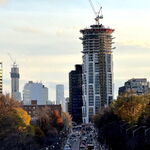S
scarberiankhatru
Guest
"As we all know from the Sheppard line, the density doesn't always materialize thanks to the middle-class NIMBY's."
Thousands of new residential units have been created in the Sheppard corridor, but remember that the subway is not finished and it's densest stretch was and probably still is between Don Mills and Scarborough Town Centre, conveniently, the area the subway did not reach. This segment already had thousands of jobs and dozens of towers (some of which are quite sketchy; the entire area is not particularly well-off by located-next-to-subway standards, and neither are most residents of Don Mills towers, for that matter) adjacent to planned stops, and there's room for plenty of new developments as well. It would also make easy connections with about 19 Scarborough bus routes.
Seems to me that the NIMBYs might have been easier to get around east of Don Mills as the area is going through significant homeownership change - tons of elderly people who've been entrenched there for 40 years have been vacating their homes, replaced by young families, renters, new Canadians, etc., all of whom would probably be much less willing to fight redevelopment, especially when you factor in resulting boosts in house/land prices that they stand to profit from.
Thousands of new residential units have been created in the Sheppard corridor, but remember that the subway is not finished and it's densest stretch was and probably still is between Don Mills and Scarborough Town Centre, conveniently, the area the subway did not reach. This segment already had thousands of jobs and dozens of towers (some of which are quite sketchy; the entire area is not particularly well-off by located-next-to-subway standards, and neither are most residents of Don Mills towers, for that matter) adjacent to planned stops, and there's room for plenty of new developments as well. It would also make easy connections with about 19 Scarborough bus routes.
Seems to me that the NIMBYs might have been easier to get around east of Don Mills as the area is going through significant homeownership change - tons of elderly people who've been entrenched there for 40 years have been vacating their homes, replaced by young families, renters, new Canadians, etc., all of whom would probably be much less willing to fight redevelopment, especially when you factor in resulting boosts in house/land prices that they stand to profit from.






